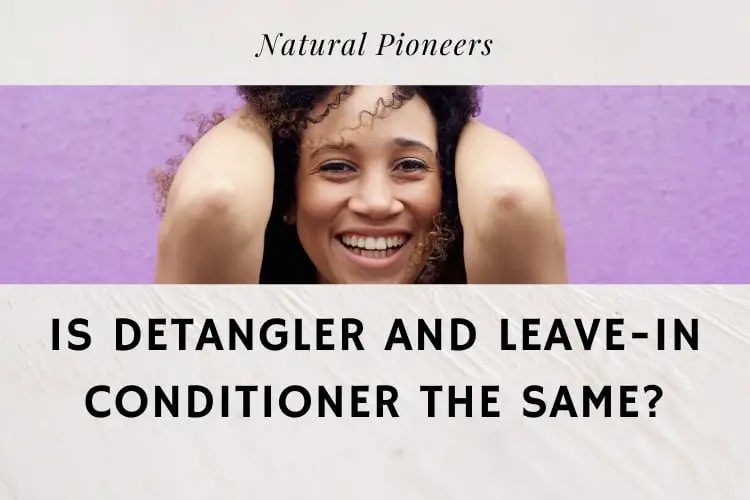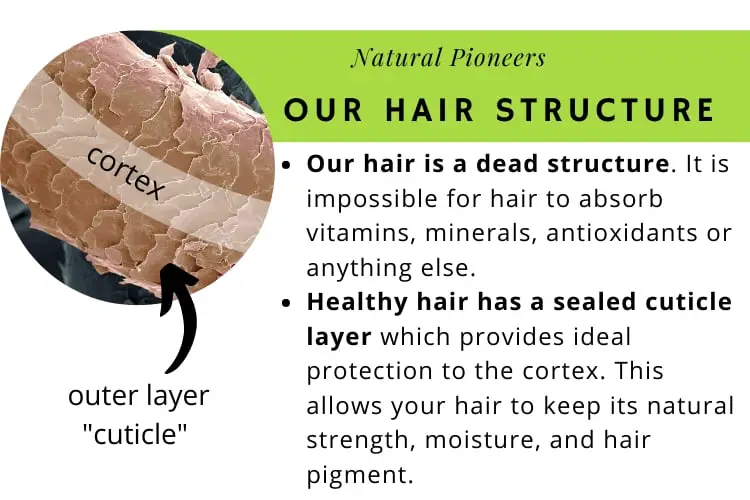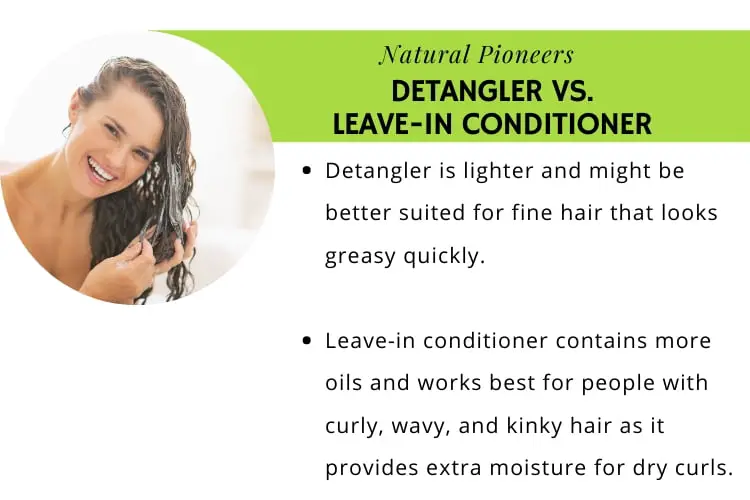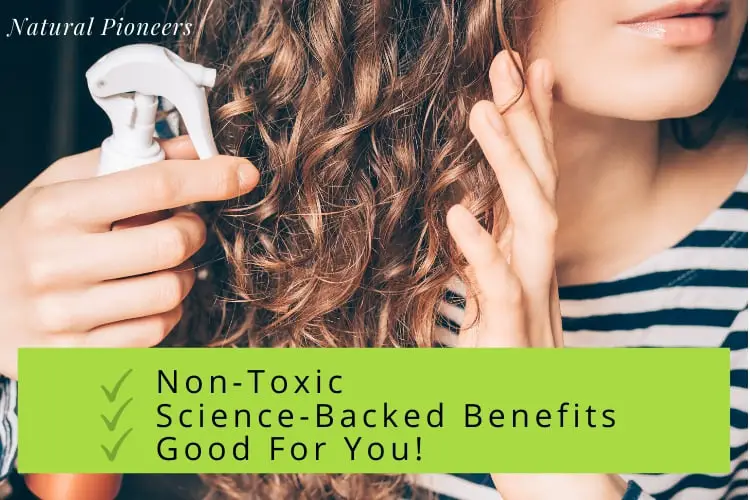
Ever wondered what the difference is between a detangler and a leave-in conditioner? I’ve used leave-in conditioners for the past 15 years and it was about time to learn if a detangler could be a valid option too. We’ll cover ingredients, how they work, what hair type they’re ideal for, and what chemicals to avoid. For smooth, shiny, and healthy hair!
Detangler and conditioner have the same basic ingredients. Both contain conditioning agents that lubricate the outer layer of hair & prevent static charge. The formulation of a detangler is lighter (ideal for fine hair). Leave-in conditioner is more creamy & moisturizing (ideal for dry, curly hair).
Let’s dive into the ingredients first!
1. Ingredient Check!
Let’s take a closer look at the ingredients. If I’ve learned one thing over the years as a researcher of non-toxic beauty products it’s this: Never trust the front label! I will guide you through the ingredients which will help answer our initial question of what is the difference between detangler and leave-in conditioner.
Let’s start with detangler. We took a popular drugstore detangler and went down the rabbit hole. Here’s what we found.
Detangler Ingredients:
WATER*, AMODIMETHICONE, GLYCERIN*, SODIUM BENZOATE, POLYSORBATE 20, DISTEARYLDIMONIUM CHLORIDE, BEHENTRIMONIUM CHLORIDE, CITRIC ACID*, FRAGRANCE, TRIDECETH-12, CETRIMONIUM CHLORIDE
Let’s translate this into words we can pronounce. The basic ingredients of a detangler are:
- Water – Water is the foundation of most liquid products
- Hair conditioning agents – To condition the outer layer of our hair
- Preservatives – Extent the shelf-life of a product
- Surfactants – Reduce static build-up
- Antistatic agents – Reduce static build-up
- Sequestering agents – Prevent product build-up
- Fragrances – Gives a product a certain scent

>> Learn more about nourishing shampoos
Alright, there are 7 basic ingredients in a detangler. What about leave-in conditioner?
Again, we took a popular drugstore product, checked the ingredients, and translated them into words you can understand. Here’s what we found.
Leave-In Conditioner Ingredients:
WATER, BUTYLENE GLYCOL, CETEARYL ALCOHOL, CETYL TRIETHYLMONIUM DIMETHICONE PEG – 8 SUCCINATE, FRAGRANCE, QUATERNIUM – 91, PROPYLENE GLYCOL, DIAZOLIDINYL UREA, MYRISTYL MYRISTATE, HYDROLYZED KERATIN, PPG – 26 – BUTETH – 26, BEHENTRIMONIUM CHLORIDE, PEG – 40 HYDROGENATED CASTOR OIL, IODOPROPYNYL BUTYLCARBAMATE, APIGENIN, OLEANOLIC ACID, BIOTINOYL TRIPEPTIDE – 1, CITRIC ACID
Again, let’s translate these chemicals into words we can understand.
- Water – Water is the foundation of most liquid products
- Fragrance – Gives a product a certain scent
- Surfactants – Reduce static build-up
- Hair conditioning agents – To condition the outer layer of our hair
- Viscosity controlling agents – Give the product a certain consistency
- Preservatives – Extend the shelf-life of a product
- Occlusives – Prevent water loss
- Antistatic agents – Reduce static build-up
You’ll find that all product formulations will be slightly different. The standard formulation, however, stays the same. As you can see above, detangler and leave-in conditioner consist of pretty much the same ingredients.
We detected slight differences and found that detanglers contain ingredients to prevent product build-up, while leave-in conditioners contain ingredients to ensure the product has a certain consistency or creaminess, as well as moisturizing ingredients that prevent water loss.
The Take-Away: Detangler and conditioner contain the same basic ingredients. The two drugstore products we compared were different in the amounts of certain ingredients. Additionally, the detangler contained ingredients to prevent product build-up, while leave-in conditioner is formulated to be more creamy and moisturizing.
The ingredients alone are not enough to detect the differences between a detangler and leave-in conditioner. Let’s take a look at how different ingredients and formulations work.
2. How Detangler & Leave-In Conditioner Work
In our ingredient check, we found, that the basic ingredients in detangler and leave-in conditioner overlap. Now, let’s see how these ingredients work and what each product is suited best for.
To get a better idea of how conditioners work in the first place, let’s take a look at rinse-out products that we normally use after shampoo.
When we wash our hair, our hair has a negative charge. Think of the negative pole of a magnet. Conditioners are positively charged. That means they are strongly attracted to your hair and evenly lubricate each hair.

>> Learn more about how shampoo works
This electrostatic interaction lubricates the surface of each hair follicle and makes combing a lot easier. Since the negative charge (-) after shampooing and the positive conditioning charge (+) balance each other out, this also helps reduce frizz. [1]
Remember: Conditioning agents lubricate the surface of our hair and reduce frizz.
Most detanglers and leave-in products work just the same way. However, their formulations are slightly different.
How Detangler Works
Detanglers are formulated to modify the hair surface. Conditioning agents are electrically charged and stick to the outer layer (cuticle) of our hair. As a result, the cuticle is smooth enough for easy combing and you won’t have to deal with static charge.
Detangler usually comes in spray bottles.
How Leave-In Conditioner Works
Leave-in conditioners, on the other hand, contain a higher amount of conditioning agents to provide additional moisture while avoiding greasiness or weighing hair down. Just as in detanglers, the conditioning agents are electrically charged and stick to the cuticle to evenly coat it.
Its use is particularly popular among people with curly hair. Unlike detangler, leave-in conditioner comes in many forms like sprays, mousses, lotions, and creams.
Detangler is lighter and might be better suited for fine hair that looks greasy quickly. Leave-in conditioner contains more oils and works best for people with curly, wavy, and kinky hair as it provides extra moisture for dry curls.
The Take-Away: Detangler and conditioner work with the same underlying mechanism. Conditioning agents are electrically charged and stick to the outer layer (cuticle) of our hair. As a result, it prevents static charge, and the cuticle is smooth enough for easy combing.

>> Learn more: Is natural shampoo better?
3. Safety Of Detanglers & Leave-In Conditioners
With the clean-beauty trend booming, you might have heard or already know about the toxins in our personal care products. To put things into perspective, these chemicals are well known to disrupt our hormones, cause cancer, and much more.
Let’s quickly go over the basics you should be aware of to make a good choice regarding your next detangling or leave-in conditioner product.
1. Ingredients To Avoid:
Surfactants, preservatives, fragrances, and propylene glycol. Not only can they do harm to your hair and scalp, but some of them are known to cause cancer (specifically breast cancer) eye, nose, and throat irritation, kidney and liver damage, and allergies. They are associated with immunotoxicity, harm our reproductive system, disrupt our hormones, can disturb normal development in children, and act as neurotoxins.
Phew, glad we got that straight!
2. How To Find A Non-Toxic Product:
I personally love the EWG Skin Deep Database. I check all my product there and have used it for a long time. Friends of mine who are pediatricians recommend it to their patients all the time.
All you need to do is click on the link and look for a product category of your choice or type in a specific product. Always make sure to compare the ingredients on the database with the one on your product – you might have bought a new formulation that isn’t on the database just yet.

3. Looking For A Fast Track?
Here are non-toxic products that I have used: Boyzz Only No Nonsense Detangler, Clean Kids Naturally Mango Mist Spray Detangler, John Masters Organics Leave-in Conditioning Mist, and my current favorite (I have dry, curly hair) SoCozy Curl Leave-In Conditioner + Therapy.
The-Take Away: Detanglers and leave-in conditioners are heavily loaded with chemicals that can do severe harm to our health. Make sure to use products that are free from toxic surfactants, preservatives, fragrances, and propylene glycol.
4. Conclusion
Detangler and conditioner contain the same basic ingredients. The two drugstore products we compared were different in the amounts of certain ingredients. Additionally, the detangler contained ingredients to prevent product build-up, while leave-in conditioner is formulated to be more creamy and moisturizing.
Both, detangler and conditioner work with the same underlying mechanism. Conditioning agents are electrically charged and stick to the outer layer (cuticle) of our hair. As a result, it prevents static charge, and the cuticle is smooth enough for easy combing.
Detanglers and leave-In conditioners are heavily loaded with chemicals that can do severe harm to our health. Make sure to use products that are free from toxic surfactants, preservatives, fragrances, and propylene glycol. We have provided some safe, non-toxic options for detanglers and leave-in conditioners in this article.
